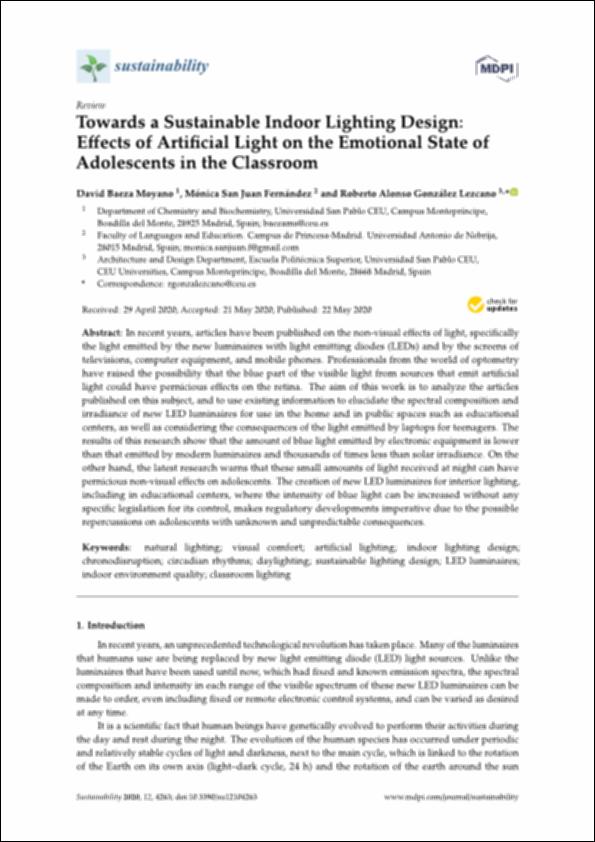Please use this identifier to cite or link to this item:
http://hdl.handle.net/10637/14593Towards a Sustainable Indoor Lighting Design Effects of Artificial Light on the Emotional State of Adolescents in the Classroom
| Title: | Towards a Sustainable Indoor Lighting Design Effects of Artificial Light on the Emotional State of Adolescents in the Classroom |
| Authors : | Baeza Moyano, David San Juan Fernández, Mónica González Lezcano, Roberto Alonso. |
| Keywords: | Indoor lighting design; Indoor environment quality |
| Publisher: | MDPI |
| Citation: | Baeza Moyano, D.; San Juan Fernández, M.; González Lezcano, R.A. Towards a Sustainable Indoor Lighting Design: Effects of Artificial Light on the Emotional State of Adolescents in the Classroom. Sustainability 2020, 12, 4263. https://doi.org/10.3390/su12104263 |
| Abstract: | In recent years, articles have been published on the non-visual e ects of light, specifically the light emitted by the new luminaires with light emitting diodes (LEDs) and by the screens of televisions, computer equipment, and mobile phones. Professionals from the world of optometry have raised the possibility that the blue part of the visible light from sources that emit artificial light could have pernicious e ects on the retina. The aim of this work is to analyze the articles published on this subject, and to use existing information to elucidate the spectral composition and irradiance of new LED luminaires for use in the home and in public spaces such as educational centers, as well as considering the consequences of the light emitted by laptops for teenagers. The results of this research show that the amount of blue light emitted by electronic equipment is lower than that emitted by modern luminaires and thousands of times less than solar irradiance. On the other hand, the latest research warns that these small amounts of light received at night can have pernicious non-visual e ects on adolescents. The creation of new LED luminaires for interior lighting, including in educational centers, where the intensity of blue light can be increased without any specific legislation for its control, makes regulatory developments imperative due to the possible repercussions on adolescents with unknown and unpredictable consequences. |
| URI: | http://hdl.handle.net/10637/14593 |
| Rights : | http://creativecommons.org/licenses/by-nc-nd/4.0/deed.es |
| ISSN: | 2071-1050 |
| Issue Date: | 22-May-2020 |
| Center : | Universidad San Pablo-CEU |
| Appears in Collections: | Escuela de Politécnica Superior |
Items in DSpace are protected by copyright, with all rights reserved, unless otherwise indicated.


